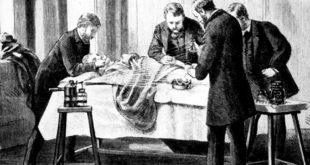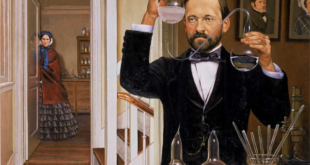Originally published in “The epidemic of Savannah, 1876: its causes the measures of prevention, adopted by the municipality during the administration of Hon. J. F. Wheaton, Mayor” in 1879
BACTERIUM LINEOLA VIBRIO LINEOLA OF EHRENBERG.

Under this designation I understand those rod bacteria, which are similar in all regards to the B. termo, but are much larger, and not only longer, but also, in comparison, wider, for which reason, I do not consider them a development form of the B. termo. I find them in swill water and in stagnant water, even though no putrefaction has been noticed, and also in slimy heaps on the surface of potatoes, and in infusions of different kinds. The cells are clearly cylindrical, about four times as long as they are wide, occasionally crooked, and possessed of strong, translucent, soft contents, filled with fatty granules, and therefore dark punctated. Their length is 3.8 up to 5 1/4 micrometer; their width is 11/2 micrometers.
They are found singly or hanging together in couples, sometimes forming crooked double rods; exceptionally, also, two double pairs, but never forming longer threads. They move like B. termo, but stronger, trembling with the one end as if they had a tail, or swimming about in curved lines forwards and backwards; then they jump a little, and again continue their circles, or rotate around one fixed point, like the arm of a lever. B. lineola forms zooglea jelly of a similar kind to B. termo, as I have stated in 1853. I observed in such zooglea that the motionless little rods, being imbedded in the water-like jelly, suddenly commence to turn, make with one end a motion like a gimlet, and swim away. Double rods, being in the state of partition, came out of the jelly and moved away. If the single rods are somewhat bent, or the double rods have knees, they make, in rotating, a snakey motion, which caused Ehrenberg to put these senseless cells amongst his vibrios. Ehrenberg at first called them bacteria; later on vibrio tremulens, and gives the size as 1/288 of a line, that is, 7 to 8 micrometer; but the size of the vibrio lineola is put at 1/300 to 1/1000 of a line, that is, 6 to 2 micrometers, so that he seems to mix together the smaller forms of the bacteria termo with the larger B. lineola. I have, therefore, with Dujardin, kept the name of lineola for the larger form, but called it a special kind of the genus bacteria. It is possible, however, that I shall include several species in the bacteria lineola, and that especially a large and elliptical form may be designated bacteria tremulens. Whether the bacterium lineola is a specific ferment I cannot say.
To the true bacteria belong, also, according to the opinion of Hoffman and others, the ferment of lactic acid. Pasteur, the discoverer of the milk ferment, describes this as champignon, short, slightly drawn in about the middle, as if two points had been connected together. The plate shows the bacterium termo, and also chains of four links are found, which show a globular bacteria form. My observations about the ferment of lactic acid have not yet been brought to a close. If you observe with the microscope the souring of milk, butter globules of all sizes and pseudo bacteria, obstruct every clear view. Soon, besides other organisms, globular B. and B. termo appear, later on, also oidium lactis. If sugar of milk is exposed to the air, with a warm temperature, in a few days it becomes dissolved and sour, innumerable bacteria form, which after awhile make a thick chalk-like sediment. It must be left to later observations which of these organisms is the true ferment and which are only secondary companions. As in the souring of milk a large number of different processes occur, the fermentation of each ferment is difficult to state. I myself found in the souring of milk globular cells similar to those in urine ferment, like those with rosary chains, hanging in toruloe form, of two, four or eight cells. A solution of sugar of milk on the 20th of February was discolored, on the 24th was sour, on the 27th its sediment consisted of globular beer ferment of rosary chains, 1.5 to 2 micrometers diameter. Pasteur says that (the souring of milk is caused by the lactic acid, which is formed from milk sugar. But alkaline and neutral milk gets sour also if it comes in contact with vibrios, which show an active power analogous to the lob upon caseine. These vibrios, which cannot be killed by boiling, but die at 105 deg. centigrade, are the bacteria of butyric acid. The name is bacterium subtilis. If milk which is sour becomes alkaline after a long time from putrefaction, segile bacteria form, according to Hoffman.
The true ferment of acetic acid has never been determined, botanically. Former observers, for instance Kutzing, describe the mother of vinegar as algous jelly, in which an enormous quantity of globular cells are imbedded. Pasteur describes acetic acid ferment as mycoderma aceti. It consists, according to him, of short constructed members of 1.5 micrometers, twice as long as wide, in rosary shape, often extended into long chains, forming a thin film on the surface. According to Pasteur, acetic acid ferment is similar to lactic acid ferment, perhaps identical with it. The members of lactic acid ferment are, however, longer and constructed less regularly. Generally we call this peculiar form of ferment fungi—vinegar ferment (atrococcs), whose true-like cells are oblong or cylindrical, and swim on the surface of alcoholic liquids which have become sour, especially beer. Pasteur plates this atrococcus as a wine ferment, which he calls mycoderma vini. He says that this mycoderma has no part in the formation of vinegar. It rather antagonizes the development of vinegar ferments and develops bouquet of the wine. Bees, also, who describes and plates this ferment as an especial kind, under the name of saccharomyces mycoderma, thinks that they have no part in the formation of vinegar.
Vinegar and lactic acid ferments need further investigation. I find that beer which has become sour, is discolored throughout and covered with a film, whose discoloring consists of oval saccharomyces and elliptical mycoderma, and an enormous multiplication of moving elliptical bacteria, similar to the bacteria termo but somewhat larger than the usual form, hanging together generally in couples, rarely in four if two just parted cells are again parting. Their motion is sometimes trembling, sometimes gliding, sometimes moving, screw-like, sometimes spinning like a top. If the acetic acid ferment multiplies, they lose their spontaneous motion and only show molecular motion. These rod bacteria fill the whole fluid; and I find rarely bacillus threads ranged into lepthothrix threads. The film on the surface is formed of the same bacteria in motionless, parallel, straight and crooked lines, and this form Pasteur has placed under the name of mycoderma aceti. We also find globular, zooglea masses, thickly filled with elliptical bacteria, partly belonging to a micrococcus species, and formed of round dots.
Certain rod bacteria seem to act as chromogene ferments. The pigment of yellow and blue milk are added since Ehrenberg’s time to the physiological functions of bacteria (vibrios). Schroeder describes these as bacterium xanthimum, being the bacteria which produce the blueish green pigment of pus.
 Pasteur Brewing Louis Pasteur – Science, Health, and Brewing
Pasteur Brewing Louis Pasteur – Science, Health, and Brewing 


